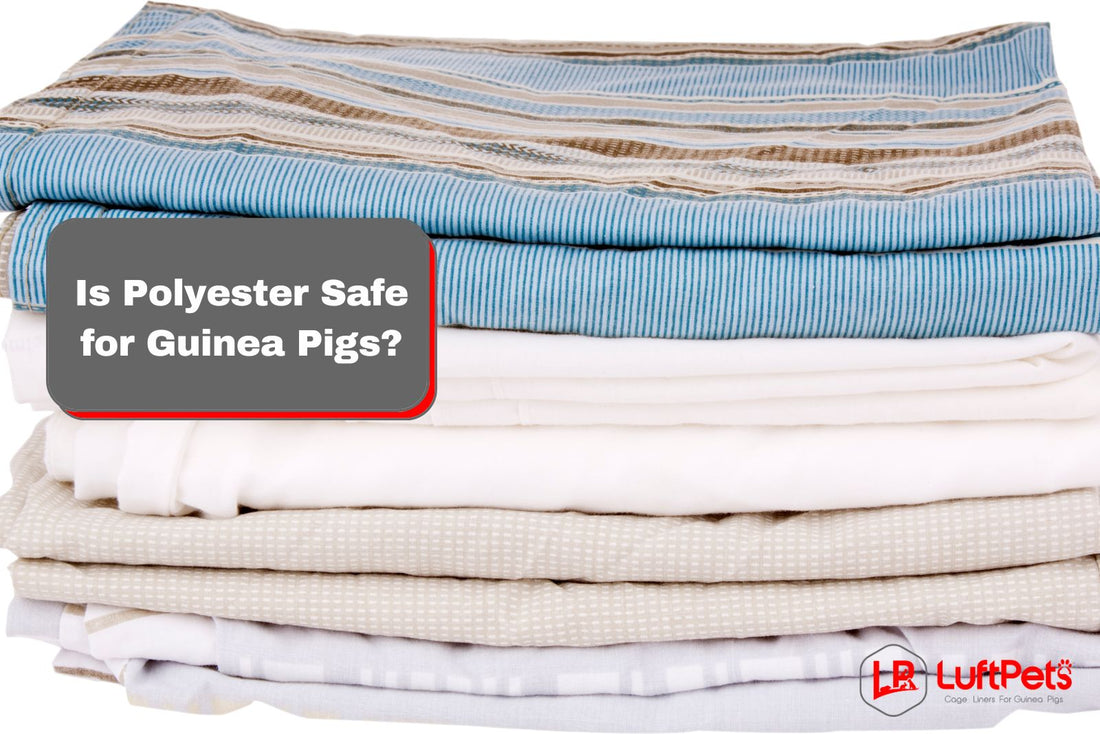Curious to know, "Is polyester safe for guinea pigs?" YES - but keep reading!
As a guinea parent, I’ve asked myself the same question after finally finding the guinea experts who showed me the magic of polyester (Hint: It's my lifesaver!)...
In this article, you’ll learn the ins and outs of polyester as a bedding material, why you need it, and why experts love it!
Scroll on for a brief, practical overview of why to say YES to polyester...
Key Takeaways
- Polyester is a durable, easy-to-clean, and hypoallergenic option for guinea pig bedding.
- Pairing polyester with an absorbent layer ensures a dry and comfortable environment for your pets.
- It’s a cost-effective solution that offers top-notch convenience and quality.
Is Polyester Safe for Guinea Pigs?
Yes, polyester isn’t just safe—it’s a top-tier choice for guinea pig bedding. Pet enthusiasts rave about its lasting durability and the breeze of cleaning it offers.
Here are 7 compelling reasons to give polyester bedding a shot:
1. Durability
Polyester is a champion when it comes to durability. Your guinea pigs can play, sleep, and explore without quickly wearing out their habitat.
After all, it’s not just a bedding superstar - you can use it in different parts of the cage to provide a consistent, comfy environment.
In fact, from my experience as a guinea parent, I found polyester to be a real game-changer (and my guinea friends love it so much!)...
It’s incredibly tough. So my guineas jump, play, and do all their cute little antics, and yet, the bedding holds up.
It's true - This material stands the test of time, which means I don't need to replace it that often...
It’s a practical choice that ensures your pets have a reliable and consistent surface, day in and day out. So you'll save both time and money.
Try polyester-based bedding now. Get a LUFTPETS guinea pig cage liner today!

2. Wrinkle Resistance
If you want bedding that stays smooth and comfy all the time, then polyester is for you.
Your guinea friends (like mine) will feel comfortable on a surface that resists wrinkles and bunching.
And here's the great part: there’s a minimal risk of pressure sores or discomfort, ensuring that your pets’ living space is always inviting and cozy.
When considering the best bedding options, it's essential to prioritize absorbent material for guinea pig cages. This ensures a clean and hygienic environment for your furry companions.
3. Quick Drying
Another aspect of polyester is its ability to dry.
You'll find that polyester doesn’t have that annoying habit of staying wet. It’s like it just shakes off the moisture.
If you're like me, you'll usually give it a quick check, and more often than not, it’s already dry.
It’s one of those small wins that make a big difference.
Do you know why I'm so OCD about dryness? A dry habitat means a healthier living space for our little friends.
And you know how it goes - dampness can lead to mold and bacteria, and that’s a no-go for your guineas.
Thankfully, polyester gives an extra layer of defense.
Is aspen bedding safe for guinea pigs? Is scented bedding safe for guinea pigs? Dive into our articles to find out!
4. Lightweight
Polyester has a practical, lightweight quality that many guinea pig owners appreciate. It’s not cumbersome or difficult to manage.
When it's time for cleaning or changing the bedding, the task is straightforward and unproblematic.
This material ensures that your pets’ living space remains clean without requiring a significant amount of effort or time.
The ease of handling polyester bedding doesn’t just make the cleaning process quicker but also more efficient.
In essence, polyester strikes a balance. It offers a clean, comfortable habitat for guinea pigs and a hassle-free maintenance experience for owners.
If you - like me - are looking for material that's easy to clean, then polyester is a superb choice of material.
5. Adaptable
Experts in a study on the evolution of polyester fabrics stated, “Polyester has evolved into the most versatile fabric and fiber in the world” [1].
Thanks to continuous innovations, it’s transformed from a rigid, less comfortable material to a soft, adaptable, and resilient fabric.
The best part? You can confidently use it in your guinea pig's cage. It will not only create a cozy and safe haven for your pets but also endure their playful, active nature.
Just as polyester has adapted to a variety of applications, it’s equally up to the task of meeting the specific needs of your furry friends.
6. Enhanced Comfort
Polyester’s adaptability extends to its comfort level, especially when treated to increase its hydrophilicity.
This is a fancy word to say they interact with water. In brief, it manages moisture better!
A study in Polymers (Basel) highlighted that with certain treatments, polyester's moisture content can be enhanced, leading to an improved user experience comparable to that of natural fibers [2].
For guinea pigs, this means bedding that’s not just durable and easy to clean, but also adept at moisture management.
Treated polyester ensures a dry, cozy environment, reducing health risks associated with dampness.
It’s another layer of care that pet owners can appreciate, knowing their furry friends are nestled in comfort that’s backed by science.
7. Budget-Friendly
When it comes to choosing bedding for guinea pigs, pet parents are often caught between ensuring comfort and managing costs.
Polyester bedding emerges as a hero in this scenario, offering a blend of comfort, safety, and affordability.
But how does it stack up against other options for bedding, and what makes it a choice worth considering?
Polyester bedding is an economical bedding material that doesn’t compromise on quality.
Unlike kiln-dried pine or aspen shavings, polyester offers a low-cost bedding alternative that is also easy to maintain.
It’s washable, which means you won’t be constantly spending on replacements, and it’s durable, standing up to the playful antics of your guinea pigs.
Now, skip to this comparison table for a brief review...
| 1. Durability | Polyester is highly durable, allowing guinea pigs to play without wearing out their habitat quickly. It requires less frequent replacements, saving time and money. |
|---|---|
| 2. Wrinkle Resistance | The material stays smooth and comfy, resisting wrinkles and bunching, ensuring a cozy living space for pets. |
| 3. Quick Drying | Polyester dries quickly, reducing the risk of mold and bacteria growth, and ensuring a healthier living space for guinea pigs. |
| 4. Lightweight | Easy to manage during cleaning or changing, making the maintenance experience hassle-free for owners. |
| 5. Adaptable | Evolved to be a versatile, soft, and resilient fabric that’s suitable for various applications, including guinea pig bedding. |
| 6. Enhanced Comfort | Treated polyester manages moisture better, ensuring a dry, cozy environment and reducing health risks associated with dampness. |
| 7. Budget-Friendly | Offers a blend of comfort, safety, and affordability, being a low-cost, easy-to-maintain alternative to other bedding materials. |
NEXT: let's learn how to enhance polyester for comfort and efficiency...
Enhancing the Efficiency of Polyester Bedding
When it comes to optimizing the living environment for guinea pigs, every detail counts.
Polyester is a popular choice among guinea pig owners for its benefits. But there are ways to enhance it to become even better. Here's how...
#1 Combining with Absorbent Layers
Guinea pigs thrive in a dry environment, and their bedding plays a pivotal role in ensuring their comfort and health.
To keep your guinea pigs in a dry and comfortable environment, you can enhance the effectiveness of polyester bedding by adding an absorbent layer.
Throwing in materials like puppy pads or paper bedding to polyester ensures rapid moisture absorption, creating a cozy, dry space for your pets.
By taking this step, you actively prevent dampness and offer your guinea pigs a relaxed and clean habitat where they can thrive.
It’s not just about elevating comfort but also ensuring your pets stay healthy and playful in a well-maintained environment.
This strategy of combining absorbent materials with polyester bedding isn’t just about comfort—it’s about creating a habitat where guinea pigs can stay healthy and happy.
Better yet, you ensure that your pals are happy, healthy, and full of vitality!
#2 Opting for Recycled Polyester
Isn’t it amazing when you find out that something you use daily has a hidden superpower?
That’s how I felt when I learned that polyester could be recycled. It’s like discovering your cozy blanket is also a superhero cape.
In fact, studies show that polyester provides a comfortable environment, and wicks moisture, all while being eco-friendly.
In his video review, Tristan from Plascon Plastics says the following about polyester, “It lasts long, it’s very durable, and it has sweat-wicking capabilities because it doesn’t hold onto water and sweat like cotton would.”
The best part? You can use it in your guinea pig’s cage. It will not only keep the space dry and comfy but also contribute to reducing waste.
Just as recycled PET plastics find a second life in polyester, your choice to use them supports a cycle of sustainability.
Check out this informative review of polyester here:
#3 Checking the Quality
Quality is paramount when selecting bedding for guinea pigs.
The quality of polyester ensures that it withstands guinea pigs' playful and explorative nature without wearing out quickly.
It's not just about finding economical bedding material but ensuring it offers long-term service, reducing bedding costs over time.
In fact, high-quality polyester fabric circulates air without giving off extra odors or moisture.
Thankfully, because high-quality polyester resists mold growth and debris buildup, you don't have to worry about dampness ruining their health or causing infections.
#4. Considering The Environment
While polyester is praised for its benefits, it’s also linked to the release of microplastics during washing.
But stop worrying - there are ways around this.
Opt for washing methods that curb microplastic release. As for an eco-friendly way to was
The most eco-friendly way to wash polyester is to make sure that the items are washed at a low temperature with a mild detergent.
Also, you should consider investing in a washing machine filter, which can help reduce microplastics from entering the water system.
#5. Making Informed Choices
Every guinea pig parent wants the best for their pets. When selecting polyester bedding, consider its longevity and environmental impact.
Opt for not only comfortable but also long-lasting pieces, reducing the frequency of replacement and, consequently, waste.
Now, let’s explore some frequently asked questions...
FAQs
1. How often should polyester bedding be cleaned?
Clean it at least once a week to maintain a hygienic environment, though it can often last longer between cleans due to its moisture-resistant properties.
2. Is polyester bedding comfortable for guinea pigs?
Yes, especially when combined with an absorbent layer, it provides a soft, dry surface that’s comfortable for guinea pigs.
3. Can polyester bedding be used for adult and young guinea pigs alike?
Absolutely, it’s a versatile option that suits guinea pigs of all ages, ensuring their comfort and safety.
Conclusion
Is polyester a good choice for guinea pig bedding? Of course, here's a wrap-up...
I've discussed its strong points - it’s long-lasting, easy to clean, and friendly for those with allergies.
Combine it with something absorbent, and you’ve got a cozy, dry haven for your guinea pigs.
So, as you weigh your options, keep in mind the practicality and affordability that comes with polyester.
Have thoughts or questions? Drop a comment below! I’m eager to hear how this info is shaping your preferred material for your pal's cage.
Resources
1. Vanoer G. Polyester… It’s What’s For Living | First Source Worldwide, LLC [Internet]. First Source Worldwide. 2019. Available from: https://www.fsw.cc/polyester-its-whats-for-living/
2. Martí M, Gisbert-Paya J, Bonet-Aracil MÁ, Jovančić P, Lis MJ, Coderch L. Increased Comfort of Polyester Fabrics. Polymers [Internet]. 2021;13:3010. Available from: https://www.ncbi.nlm.nih.gov/pmc/articles/PMC8433904/



